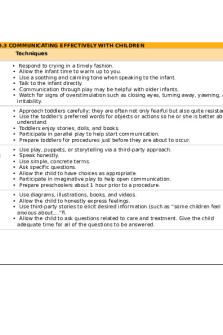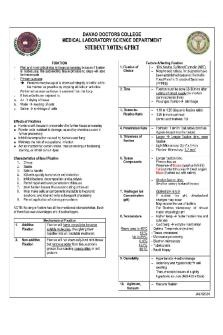Artist and Artisan, Medium and Techniques PDF

| Title | Artist and Artisan, Medium and Techniques |
|---|---|
| Author | J L |
| Course | Art Appreciation |
| Institution | Our Lady of Fatima University |
| Pages | 4 |
| File Size | 81.6 KB |
| File Type | |
| Total Downloads | 1 |
| Total Views | 143 |
Summary
Artist and Artisan, Medium and Techniques...
Description
WEEK 3-4: ART AND ARTISANS: PRODUCTION PROCESS, MEDIUM, TECHNIQUES I. ARTISTS AND ARTISANS 2. Production Gathering and sourcing the materials a) Artists needed for the creation of the artwork. Dedicate only to the creative side. 3. Postproduction visually pleasing work only for the Process where decision is drawn as to enjoyment and appreciation. No how an artwork will be circulated not functional value. only in the world of art, but also in the many publics b) Artisans Manual worker who makes items with III. MEDIUM & TECHNIQUES APPROACH his or her hands. Create things with great beauty as well as being functional. MEDIUM Before industrial revolution everything The word medium, which comes from the Latin word medium, denotes the means by which an was basically made by artisans. smiths (goldsmiths, blacksmiths, locksmiths, artist communicates his idea. It is the stuff out of which he creates a work of gunsmiths) weavers, carpenters, potters. art. These are the materials which the artist uses to c) Manager translate his feelings or thought into a beautiful reality. advise, represents or handles the This may be pigment in painting, stone, wood business affairs of artists. brick, concrete and various building materials in architecture, steel, marble, bronze, and wood in d) Curator person who selects artwork and often sculpture, sound in music and words in interprets art. Arranges for the setting literature. and provides information for artists regarding shipping or documentations A. VISUAL needed and responsible for writing The visual or spaces are those whose labels, catalog essays and other mediums can be seen, and which supporting content for an exhibition as occupy space. well, must have an academic degree in These are grouped into two classes. art and art history. 1. dimensional or two-dimensional arts e) Dealer include painting, drawing buys art at the right time with the right printmaking, and photography. price and sells it at the right time with 2. Three dimensional the right price, but not necessarily deal The community planning, industrial with artists on a personal level. design and the crafts like ceramics and furniture making f) Collector Mediums: Person who loves certain pieces of art/paintings and collect art not a) Watercolor necessary to sell later but the chance is As a medium is difficult to handle there. “Art lover” because it is difficult to produce warm II. PRODUCTION PROCESS 1. Pre-production The artist always begins with an idea that he wants to express or communicate with his audience. It may not be necessarily fully formulated. Explore exposure, research, and other approaches to gather idea before actually making the artwork.
and rich tones. While changes may be made once the paint has been applied such changes normally tend to make the color less luminous. This defect however are rendered by watercolor artists through some techniques
b) Fresco This is the painting on a moist plaster surface with colors ground in water or a limewater mixture. The colors dry into plaster, and the
Fresco must be done quickly because it is an exacting medium
picture becomes a part of the wall. c) Tempra Paints that are mineral pigments mixed
WEEK 3-4: ART AND ARTISANS: PRODUCTION PROCESS, MEDIUM, TECHNIQUES with egg yolk or egg white and ore. paints which turn yellowish or darker over a long of period They are often used as a binder due to of time. its film forming properties and rapid h) Charcoal drying rate. These are carbonaceous materials obtained by heating wood or other organic substances in the absence of d) Pastel This is a stick of dried paste mage of air. pigments ground with chalk and Charcoal is used in representing broad compounded with gum water. masses of light and shadow. Like Its colors are luminous, and it is a very drawing pencil, soft charcoal produces flexible medium. Some artists use a the darkest value, while the darkest fixing medium or a protecting surface produces the lightness tone. such a glass, but when the chalk rubs, i) Crayons the picture loses some of its brilliance. These are pigments bound by wax and compressed into painted sticks used for e) Encaustic This is one of the early mediums drawing especially among children in used by the Egyptians for the painted the elementary grade. portrait on mummy cases. They adhere better on paper surface. This is done by painting with wax colors j) Bistre fixed with heat. It is a brown pigment extracted from Painting with wax produces luster and the soot of wood, and often used in pen radiance in the subject making them and wash drawings. appear at their best in portraits. k) Mosaic Art is a picture or decoration made of f) Oil Painting is one of the most expensive small pieces of inlaid colored stones or art activities today because of the glass called “tesserae” which most prohibitive cost of materials. often are cut in into squares glued on a In oil painting, pigments are mixed with surface with plaster or cement. linseed oil and applied to the canvas. Mosaic is usually classified as painting. One good quality of oil paint as a Although the medium used is medium is its flexibility. not strictly pigment. The artist may use brush, palette knife Mosaic art is an important feature of or even his bare hands when applying Byzantine churches. A prominent paint in his canvass. religious artwork in Manila done in In some cases we do not even notice mosaic is found in the altar of Sta. Cruz the artist’s strokes because the paint is Church showing a wounded white lamb, applied very smoothly. symbolizing Christ, with a stream that One distinctive characteristic of oil flows down directly to the tabernacle paints, compared with other mediums, l) Stained Glass is that they dry slowly and the painting As an artwork is common in Gothic may be changed and worked over a Cathedrals and churches. long period of time. This is made by combining many small Painting done in oil is glossy and lasts pieces of colored glass which are held long. together by bands of lead. g) Acrylic m) Tapestry This medium is used popularly by contemporary painters because of the transparency and quick drying characteristics of water color and the flexibility of oil combined. This synthetic paint is mixed with acrylic emulsion as binder for coating the surface of the artwork. Acrylic paints do not tend to break easily, unlike oil on festive occasions to provide This is a fabric consisting of a warp upon warmth. which colored threads are woven by hand to produce a design, often pictorial and for n) Drawing It is usually done on paper, using wall hangings and furniture covering.
During the middle Ages, they were hung on the walls of palaces and in Cathedrals
pencil pen and ink, or charcoal. It is the most fundamental of...
Similar Free PDFs

PERT AND CPM Techniques
- 66 Pages

Coaching Model and Techniques
- 5 Pages

COUNSELING SKILLS AND TECHNIQUES
- 7 Pages

Chapter 3 Artist and the Artisans
- 13 Pages
Popular Institutions
- Tinajero National High School - Annex
- Politeknik Caltex Riau
- Yokohama City University
- SGT University
- University of Al-Qadisiyah
- Divine Word College of Vigan
- Techniek College Rotterdam
- Universidade de Santiago
- Universiti Teknologi MARA Cawangan Johor Kampus Pasir Gudang
- Poltekkes Kemenkes Yogyakarta
- Baguio City National High School
- Colegio san marcos
- preparatoria uno
- Centro de Bachillerato Tecnológico Industrial y de Servicios No. 107
- Dalian Maritime University
- Quang Trung Secondary School
- Colegio Tecnológico en Informática
- Corporación Regional de Educación Superior
- Grupo CEDVA
- Dar Al Uloom University
- Centro de Estudios Preuniversitarios de la Universidad Nacional de Ingeniería
- 上智大学
- Aakash International School, Nuna Majara
- San Felipe Neri Catholic School
- Kang Chiao International School - New Taipei City
- Misamis Occidental National High School
- Institución Educativa Escuela Normal Juan Ladrilleros
- Kolehiyo ng Pantukan
- Batanes State College
- Instituto Continental
- Sekolah Menengah Kejuruan Kesehatan Kaltara (Tarakan)
- Colegio de La Inmaculada Concepcion - Cebu











